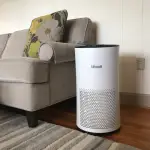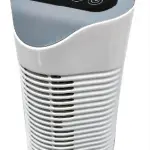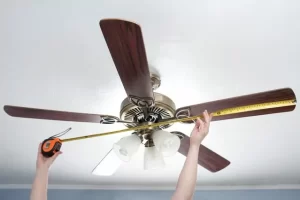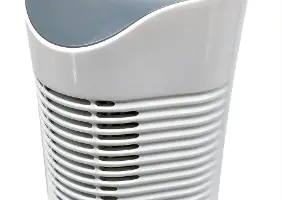When it comes to cooling your home efficiently and cost-effectively, two popular options are there which are the Attic fan and the whole-house fan. Both of these fans are designed to improve indoor ventilation, but they work differently and offer distinct advantages. In this comprehensive guide, I will delve into the workings, benefits, and installation procedures of both attic fans and whole-house fans. By understanding the differences between the two, you will be able to understand everything you want to know about these two.
Quick Response
An attic fan primarily focuses on cooling the attic space to improve energy efficiency and prevent heat transfer to the living areas below. It helps maintain a cooler attic temperature, reducing the workload on the air conditioning system and creating a more comfortable indoor environment. Additionally, attic fans can offer moisture control, prevent mold growth, and extend the lifespan of roof shingles. They operate throughout the day and are more effective in hot climates with proper attic insulation.
On the other hand, a whole-house fan cools the entire home by drawing in cool outdoor air and expelling warm indoor air. It works best during cooler evenings and mornings, providing rapid cooling for the entire house. Apart from its cooling benefits, a whole-house fan continuously improves indoor air quality by facilitating air exchange. This eco-friendly cooling option consumes less energy than traditional air conditioning systems and is well-suited for homeowners in climates with cool evenings and nights.
Let’s dive deep into the topic, and understand both Attic Fan, and Whole House Fan one by one, and understand how they differ…
How Does an Attic Fan Work?
An attic fan is a ventilation system installed in the attic space of a home. It operates by drawing in outside air through vents and exhausting hot air from the attic to the outside. Attic fans are equipped with temperature sensors and automatic thermostats that activate the fan when the attic temperature exceeds a certain level.

The process begins with the attic fan pulling cooler outdoor air through strategically placed vents or louvers. As the fresh air circulates through the attic, it flushes out trapped heat and moisture. The hot air is then expelled outside, effectively reducing the attic’s temperature and preventing the transfer of heat into the living spaces below.
Is an Attic Fan Worth It?
Whether an attic fan is worth it depends on several factors, including the climate of your area, attic insulation, and overall home cooling needs. These fans can offer several benefits, but their effectiveness varies based on specific conditions. Let’s explore the advantages and considerations to determine if an attic fan is worth it for your home:
Benefits of an Attic Fan:
- Improved Energy Efficiency: Attic fans can help reduce the temperature in the attic space, which in turn lowers the temperature of the living areas below. By preventing excessive heat buildup in the attic, the workload on your air conditioning system may decrease, leading to potential energy savings.
- Enhanced Indoor Comfort: During hot weather, attics can become extremely hot, and this heat can radiate down into the living spaces, making them uncomfortable. An attic fan helps maintain a cooler attic, reducing heat transfer into the rooms below and creating a more comfortable indoor environment.
- Moisture Control: Attic fans can help remove excess humidity from the attic, preventing the growth of mold and mildew, which can lead to structural damage and health issues.
- Roof Protection: By keeping the attic cooler, attic fans can extend the lifespan of your roof shingles by reducing the damaging effects of excessive heat.
Considerations and Limitations:
- Climate: Attic fans are generally more effective in climates with hot and sunny weather. In areas with mild or cool summers, the impact of an attic fan on cooling may be less noticeable.
- Insulation: For attic fans to work efficiently, it’s essential to have adequate insulation in your attic. If your attic is poorly insulated, the benefits of the fan may be limited.
- Time of Use: Attic fans operate throughout the day, primarily to prevent heat buildup in the attic. However, their cooling effect on the living spaces may be less noticeable during peak daytime temperatures.
- Noise: Some attic fans can be noisy, and this noise may carry into the living areas if the fan is not properly installed or maintained.
- Installation: Proper installation and positioning of the attic fan are crucial for its effectiveness. Improper installation may lead to suboptimal performance and reduced benefits.
How to Install an Attic Fan?
Installing an attic fan involves several steps, and it is crucial to follow safety guidelines and manufacturer instructions carefully. Here is a general overview of the installation process:
Step 1: Select the Right Fan
Choose an attic fan size suitable for your attic space and climate.
Step 2: Determine Placement
Locate the ideal spot for the fan, typically near the roof’s peak, and ensure proper attic venting.
Step 3: Prepare the Attic
Clear any debris or obstructions, and make sure there is adequate wiring and support for the fan.
Step 4: Install the Fan
Secure the fan to the attic floor or roof, and connect the wiring to the thermostat and power source.
Step 5: Test and Adjust
Check the fan’s operation and adjust the thermostat settings to suit your needs.
How Do Whole House Fans Work?
A whole-house fan is an energy-efficient cooling system designed to bring in fresh outdoor air and expel warm indoor air, creating a breeze throughout the home. It is usually installed in the ceiling of the top floor and works best in the evening and early morning when the outside air is cooler.
When turned on, the whole-house fan pulls air from open windows and doors, drawing it through the living spaces and into the attic. As the warm indoor air is pushed into the attic, it is then expelled through attic vents, effectively cooling down both the attic and the living areas.
Is a Whole House Fan Worth It?
Whether a whole-house fan is worth it depends on various factors, including your climate, lifestyle, and specific cooling needs. For many homeowners, whole-house fans can be a valuable and cost-effective cooling solution, but it may not be the best choice for everyone.
Let’s explore the benefits and considerations to determine if a whole-house fan is worth it for you:

Find Whole House Fan on Amazon
Benefits of a Whole House Fan:
- Energy Efficiency: Whole-house fans use significantly less energy compared to traditional air conditioning systems. They draw in cool outdoor air and expel warm indoor air, providing effective cooling at a fraction of the energy cost.
- Rapid Cooling: These fans are particularly useful during cooler evenings and early mornings when outdoor temperatures drop. They can quickly cool down the entire home, making it more comfortable for sleeping and living.
- Improved Indoor Air Quality: Whole-house fans facilitate air exchange by continuously bringing in fresh outdoor air. This helps eliminate stale indoor air, odors, and pollutants, creating a healthier living environment.
- Cost Savings: By reducing the reliance on air conditioning, whole-house fans can lead to potential cost savings on your utility bills, especially during mild weather when air conditioning use is minimized.
- Eco-Friendly: As whole-house fans consume less energy and use natural ventilation, they are considered more environment-friendly than traditional AC units.
Considerations and Limitations:
- Climate: Whole-house fans work best in regions with cooler evenings and nights. In hot and humid climates, their effectiveness may be limited, as they bring in outdoor air that may not be significantly cooler than indoor air.
- Weather Dependency: These fans rely on outdoor temperatures to provide cooling. If your climate experiences long periods of hot weather, a whole-house fan may not be sufficient to meet your cooling needs.
- Noise: Whole-house fans can produce noise during operation, which may be a concern for some homeowners, especially if they plan to run the fan while sleeping.
- Allergies and Pollen: Bringing outdoor air into the home can also introduce allergens and pollen, which might be a concern for individuals with allergies.
- Installation: Proper installation of a whole-house fan is crucial for its optimal performance. It may require more complex installation compared to other cooling solutions, and professional assistance might be necessary.
How to Install a Whole House Fan?
Whole-house fan installation is more involved than attic fan installation and might require professional assistance. The process typically involves the following steps:
Step 1: Select the Right Fan
Choose a whole-house fan size suitable for your home’s square footage and ventilation needs.
Step 2: Determine Placement
The fan is typically installed in the ceiling of a central hallway or in the attic floor near the center of the house.
Step 3: Prepare the Attic
Ensure adequate attic venting and make any necessary modifications to accommodate the fan’s size.
Step 4: Install the Fan
Mount the fan securely to the ceiling or attic floor, connect the wiring to a switch or timer, and set up any required ductwork.
Step 5: Test and Adjust
Once installed, test the fan’s operation and adjust settings to ensure optimal airflow and cooling.
Whole House Fan vs Attic Fan: Major Differences
While both attic fans and whole-house fans contribute to home cooling and ventilation, they operate differently and offer distinct advantages:
- Scope of Cooling: Attic fans primarily focus on cooling the attic space, preventing heat buildup and potential damage to the roof. Whole-house fans, on the other hand, cool the entire home by pulling fresh outdoor air through open windows and exhausting warm indoor air into the attic.
- Time of Use: Attic fans are designed to operate throughout the day, maintaining a cooler attic temperature and reducing the load on the air conditioner. Whole-house fans are most effective during the evening and early morning when outdoor temperatures are cooler.
- Indoor Air Quality: Both fans can improve indoor air quality by facilitating air exchange, but whole-house fans excel in this aspect as they continuously bring in fresh air from outside.
- Energy Efficiency: Both attic fans and whole-house fans are generally more energy-efficient than traditional air conditioning systems, leading to potential cost savings on utility bills.
Attic Fan Vs. Whole House Fan Difference Table
To provide a quick comparison between attic fans and whole-house fans, the following table highlights some key points:
| Feature | Attic Fan | Whole House Fan |
|---|---|---|
| Cooling Scope | Attic space | Entire home |
| Time of Use | Throughout the day | Evening and early morning |
| Indoor Air Quality | Moderate | Improved with continuous airflow |
| Energy Efficiency | Energy-efficient | Energy-efficient |
| Cooling Effectiveness | Limited direct indoor impact | Rapid cooling of indoor spaces |
| Weather Dependency | Not weather-dependent | Works best in cool evenings |
| Installation Difficulty | Moderate | More complex, and may require a professional. |
FAQs
Are there any safety considerations when using attic fans or whole-house fans?
Safety considerations for both types of fans include proper installation, regular maintenance, and ensuring that the fans are adequately secured. Additionally, be cautious about any exposed wiring and follow manufacturer guidelines.
Can I use both an attic fan and a whole-house fan in my home?
Yes, you can use both types of fans in your home, depending on your cooling needs and the specific areas you want to target for ventilation.
Which fan type is more cost-effective in the long run, considering energy savings?
The cost-effectiveness of either fan type depends on various factors such as climate, usage patterns, and the efficiency of your air conditioning system. Both attic fans and whole-house fans generally offer energy savings compared to traditional air conditioning, but the extent of savings can vary.
Can I control the operation of attic fans and whole-house fans with smart home systems?
Some modern attic fans and whole-house fans come with smart home integration options which allow you to control their operation through compatible devices or mobile apps.
Conclusion
When it comes to choosing between an attic fan and a whole-house fan, it’s essential to consider the specific cooling needs of your home, climate, and lifestyle. Attic fans are excellent for maintaining a cooler attic, improving energy efficiency, and controlling moisture. On the other hand, whole-house fans offer rapid cooling for the entire home during cool evenings and mornings, leading to potential energy savings and enhanced indoor air quality.
Ultimately, the decision between an attic fan and a whole-house fan will depend on your preferences, budget, and the climate you live in. Both fans can complement each other and be part of a comprehensive cooling strategy for your home. Always consult with a professional HVAC technician to determine the most suitable cooling solution tailored to your specific needs and home layout.










Add Comment